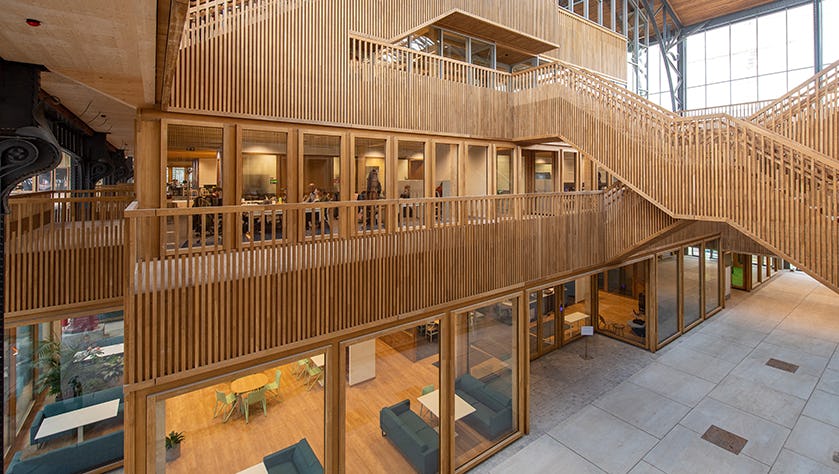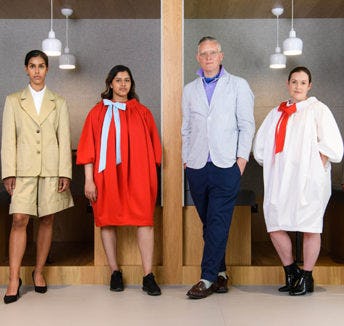
With green issues high up on people’s political and personal agendas, it’s no surprise that sustainability is of increasing concern when it comes to how and where we work.
In fact, studies show that people are more likely to choose employers whose business practices are sustainable – and that they prefer accommodation with planet-friendly features. As the influence of younger generations grows, their demands are even changing the way workspaces are designed and constructed.
In itself, hybrid working – where employees’ time is split between a corporate HQ, a local ‘satellite’ space and home – is better for the planet than the traditional 9-to-5 model. In cutting the need for commuting, it helps to reduce the carbon footprint of businesses.
Above and beyond that, though, as new coworking centres are developed, architects are paying special attention to sustainability. From repurposing existing buildings to sourcing renewable materials, collecting rainwater and using innovative solar protection glass, they’re taking steps to ensure eco-friendly construction.
Here, we take a look at some of the greenest flexspaces around.
Spaces Tour & Taxis, Brussels
Tour & Taxis is located in one of Belgium’s former shipping and customs hubs. Close to the Brussels Canal and Gare Maritime, a grand old freight station, it fell into disuse in the late 20th century, its stunning brick, glass and wrought-iron buildings left derelict.
Now, though, an ambitious redevelopment project has revived the site. With more than 4,000sqm of corporate spaces, residential buildings and retail units created, the new Tour & Taxis complex also hosts a state-of-the-art Spaces, set within the sustainably refurbished Gare Maritime.
A glass and wooden roof covers the old steel struts of the station, which have been augmented with cross-laminated timber, a renewable material made by glueing together panels of wood to create a material that’s light, sturdy and can be repurposed later.
Rated Outstanding by BREEAM (Building Research Establishment Environmental Assessment Method), Gare Maritime is also carbon neutral, running entirely on geothermal and solar power. Its roof hosts an incredible 17,000sqm of solar panels – around the amount you’d need to power 340 average-sized homes.
Meanwhile, rainwater is collected to water Tour & Taxis’ ten gardens, which are planted around four different themes: woodland, grass, flowers and fragrance.
Spaces Omniturm, Frankfurt
Built in Frankfurt’s financial district, the Omniturm was Germany’s first mixed-use high-rise building. With a distinctive ‘hip swing’ shape – its central floors splay from the building’s centre to make space for residents’ terraces – it has become a notable feature of the city’s skyline, at the same time as helping to set a new standard in sustainability.
Awarded a platinum certificate by LEED (Leadership in Energy and Environmental Design), the Omniturm boasts intelligent air-conditioning, high-performance heated/chilled ceilings and heating regulation that allows for the temperature in individual zones or even single offices to be controlled.
A key feature of the building – where Spaces Omniturm is spread across five floors – is its solar protection glazing. This glass has a special coating that’s designed to reduce the amount of heat entering a space, reflecting and absorbing light as well as filtering it for reduced glare. This helps to reduce the need for air-conditioning and artificial light and heat, ultimately cutting the building’s carbon footprint.
The Omniturm also collects and makes use of rainwater, employs LED lighting, has plentiful parking space for bicycles and offers charging stations for electric vehicles.
Spaces De Walvis, Amsterdam
Spaces has helped to bring new life to the iconic De Walvis building in Amsterdam, the Netherlands. Standing proud above the city’s Western Isles, De Walvis – ‘the whale’ in English – has been redeveloped with an emphasis on sustainability and creating a sense of beauty.
Upgraded to achieve BREEAM’s certificate of excellence, De Walvis now has higher ceilings, benefits from an abundance of natural light and has windows with triple-coated solar control glass. Spaces also has its own ‘indoor jungle’ – sure to help breathe life into the weariest work days.
It’s also hoped that De Walvis will receive WELL, in addition to BREEAM, certification. WELL is a system for measuring features of the built environment that affect human health, assessing factors such as air, water, light and comfort.
Spaces Koneser, Warsaw
Centrum Praskie Koneser in Warsaw, Poland, is the modern reimagining of a former vodka distillery. Located on the eastern side of the capital, the centre sits at the heart of the Old Praga district, with tasteful contemporary architecture that harks back to the area’s industrial past.
Its new Monopol building, where Spaces is spread over three floors, was carefully designed with the life cycles of materials in mind. Everything used in its construction was subject to assessment, and the property has been awarded an interim certificate of excellence by BREEAM for its outstanding light levels and energy efficiency.
Spaces has exclusive use of the Monopol building’s outdoor terrace and lawn, which will be kept hydrated by rainwater saved by a special collection system.
As with several of Poland’s other Spaces, Spaces Koneser is also home to a plethora of plants. As a Harvard study shows, a green office is a productive office!
Enjoy this? You might also like these Spaces magazine stories:
Spaces Oslo: the new building created with zero carbon emissions
Share this article
 Read now Spaces Oslo: the new building created with zero carbon emissions
Read now Spaces Oslo: the new building created with zero carbon emissions
 Read now What to wear for hybrid working, post-pandemic
Read now What to wear for hybrid working, post-pandemic